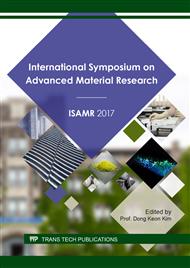[1]
X. J. Hu, Y. G. Liu, H. Wang. G. M. Zeng, X. Hu, Y. M. Guo, T. T. Li, A. W. Chen, L. H. Jiang, F. Y. Guo, Adsorption of copper by magnetic graphene oxide-supported β-cyclodextrin: Effects of pH, ionic strength, background electrolytes, and citric acid, Chem. Eng. Res. Des. 93 (2015).
DOI: 10.1016/j.cherd.2014.06.002
Google Scholar
[2]
M. Prasanthi, M. Jayasravanthi, R. Nadh, Kinetic, isotherm and thermodynamics investigation on adsorption of divalent copper using agro-waste biomaterials, Musa acuminate, Casuarina equisetifolia L. and Sorghum bicolor, Polish J. Chem. Tech. 18(2) (2016).
DOI: 10.1515/pjct-2016-0031
Google Scholar
[3]
H. Guolin, Y. Chuo, Z. Kai, S. Jeffrey, Adsorptive removal of copper ions from aqueous solutions using cross-linked magnetic chitosan beads, Chin. J. Chem. Eng. 17(6) (2009) 960-966.
DOI: 10.1016/s1004-9541(08)60303-1
Google Scholar
[4]
F. Zhao, E. Repo, Y. Meng, X. Wang, D. Yin, M. Sillanpää, An EDTA-β-cyclodextrin material for adsorption of rare earth elements and its application in preconcentration of rare earth elements in seawater, J. Coll. Interf. Sci. 465 (2016) 215-224.
DOI: 10.1016/j.jcis.2015.11.069
Google Scholar
[5]
J. Wang, L. Wang, H. Yu, Zain-ul-Abdin, Y. Chen, Q. Chen, W. Zhou, H. Zhang, X. Chen, Recent progress on synthesis, property and application of modified chitosan: An overview, Int. J. Biologic. Macromol. 88 (2016) 333-344.
DOI: 10.1016/j.ijbiomac.2016.04.002
Google Scholar
[6]
W. S. Wan Ngah, S. Fatinathan, Adsorption characterization of Pb(II) and Cu(II) ions onto chitosan-tripolyphosphate beads: Kinetic, equilibrium and thermodynamic studies, J. Environment. Manag. 91(4) (2010) 958-969.
DOI: 10.1016/j.jenvman.2009.12.003
Google Scholar
[7]
W. S. Wan Ngah, N. F. Md Ariff, M. A. K. M. Hanafiah, Preparation, characterization, and environmental application of crosslinked chitosan-coated bentonite for tartrazine adsorption from aqueous solutions, Water, Air and Soil Pollution. 206(1) (2010).
DOI: 10.1007/s11270-009-0098-5
Google Scholar
[8]
W. S. Wan Ngah, N. F. Md Ariff, A. Hashim, M. A. K. M. Hanafiah, Malachite green adsorption onto chitosan coated bentonite Beads: isotherms, kinetics and mechanism, Clean- Soil, Air, Water. 38(4) (2010) 394-400.
DOI: 10.1002/clen.200900251
Google Scholar
[9]
Y. S. Ho, G. McKay, A comparison of chemisorption kinetic models applied to pollutant removal on various sorbents, Process Saf. Environ. Protect. 76(4) (1998) 332-340.
DOI: 10.1205/095758298529696
Google Scholar
[10]
J. Febrianto, A. K. Natasia, J. Sunarso, Y. H. Ju, N. Indraswati, S. Ismadji, Equilibrium and kinetic studies in adsorption of heavy metals using biosorbent: A summary of recent studies, J. Hazard. Mater. 162(2-3) (2009) 616-645.
DOI: 10.1016/j.jhazmat.2008.06.042
Google Scholar
[11]
Y. S. Ho, G. McKay, The kinetics of sorption of divalent metal ions onto sphagnum moss peat, Water Res. 34(3) (2000) 735-742.
DOI: 10.1016/s0043-1354(99)00232-8
Google Scholar
[12]
I. Langmuir, The constitution and fundamental properties of solids and liquids, J. Chem. Soc. 38(11) (1916) 2221-2295.
DOI: 10.1021/ja02268a002
Google Scholar
[13]
F. Fadzil, S. Ibrahim, M. A. K. M. Hanafiah, Adsorption of lead(II) onto organic acid modified leaf powder: Batch and column studies, Process. Saf. Environ. 100(Ii) (2016) 1-8.
DOI: 10.1016/j.psep.2015.12.001
Google Scholar
[14]
A. S. K. Krishna, S. J. Jiang, Chitosan-functionalized graphene oxide : A novel adsorbent an efficient adsorption of arsenic from aqueous solution, J. Environ. Chem. Eng. 4(2) (2016) 1698–1713.
DOI: 10.1016/j.jece.2016.02.035
Google Scholar
[15]
S. Rangabhashiyam, N. Anu, M. S. Giri Nangopal, N. Selvaraju, Relevance of isotherm models in biosorption of pollutants by agricultural byproducts, J. Environ. Chem. Eng. 2(1) (2014) 398–414.
DOI: 10.1016/j.jece.2014.01.014
Google Scholar
[16]
Y. Zhu, Y. Zheng, A. Wang, A simple approach to fabricate granular adsorbent for adsorption of rare elements, Int. J. Biol. Macromol. 72 (2015) 410-420.
DOI: 10.1016/j.ijbiomac.2014.08.039
Google Scholar
[17]
H. M. F. Freundlich, Over the adsorption in solution, J. Phys. Chem. 57 (1906) 385-470.
Google Scholar
[18]
A. A. GAlhoum, M. G. Mahfouz, S. T. Abdel-Rehem, N. A. Gomaa, A. A. Atia, T. Vincent, E. Guibal, Diethylenetriamine-functionalized chitosan magnetic nano-based particles for the sorption of rare earth metal ions [Nd(III), Dy(III) and Yb(III)] Cellulose 22(4) (2015).
DOI: 10.1007/s10570-015-0677-0
Google Scholar


